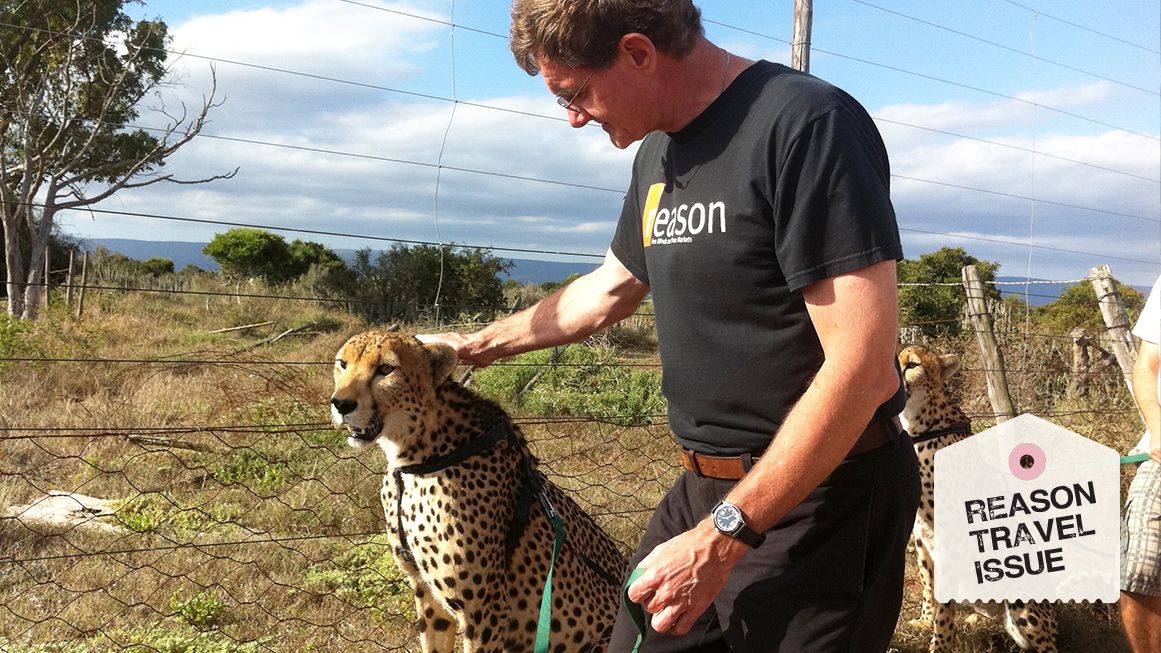Wild Animals Are Thriving on South Africa's Private Reserves and Game Farms
Land safeguarded by private industry in South Africa is almost three times greater than land under government protection.

This is part of Reason's 2025 summer travel issue. Click here to read the rest of the issue.
Sitting in the front seat of an open Land Rover being driven furiously backward for about a half-mile while being chased by a bugling, ear-flapping, and very pissed off elephant matriarch is, well, pretty exciting. Our guide later speculated that she had been spooked earlier by a roving pride of lions.
This incident occurred during our stay at the Shibula Safari Lodge in the 140-square-mile, privately owned Welgevonden Game Reserve. The reserve is in the Waterberg District in the northern Limpopo province of South Africa.
Besides being chased by an angry elephant, what happened while my wife Pamela and I visited Shibula? We saw a contest between two cape buffalo as they crashed their heavy horns loudly into one another. We learned that giraffes, tall as they are, are surprisingly hard to spot as they blend into the veldt less than 200 feet away. A troupe of baboons hopped onto the walls of our outdoor shower to observe closely the strange bathing rituals of two naked apes. We watched rhinos sedately grazing, zebras playfully jostling one another, a majestic kudu browsing the bush, and a lioness resting in the shade. For dinner, we enjoyed the sweet flavor of springbok steaks.
One particularly amusing episode occurred when a mother cheetah tried to school her two adolescent cubs on how to hunt warthogs. She sicced them on a small herd of warties and then stood back to watch them hunt. As the cubs darted forward, the herd broke into what can be described only as a mad swirling random scramble. Confused by the warthog whirlpool, the cubs looked back toward their mom and gave up. I swear the older cheetah shook her head in embarrassed dismay.
Speaking of cheetahs, one high point of our visit to South Africa was walking the countryside with the big cats on leashes at the privately owned and run Daniell Cheetah Project. There are fewer than 7,000 cheetahs still in the wild. So the chief goal of the project is to bolster the species' population while preventing inbreeding.
Upon arrival, handlers introduce you to some of their other cats. When Pamela sat down to play with two frisky 4-month-old lion cubs, she discovered when one leapt into her lap that they had very big paws with claws. The cubs also spent some time stalking a small boy who clearly realized he was being hunted and so scooted to hide behind his oblivious parents. While petting cheetahs, you learn that they purr loudly as they lick you with tongues that are considerably less rough than your housecat's. Also, the fur of their black spots sticks out like Braille dots above their golden coats.
The highlight of the visit was walking with leashed cheetahs down a country lane for a mile or so. The big cats were on high alert surveying the landscape for possible prey. Along the way, we picked up some souvenirs: quills shed by local porcupines.
Private reserves such as Shibula and the Daniell Cheetah Project don't just thrill tourists. They play a critical role in restoring and protecting African wildlife. South Africa has an estimated 9,000 private wildlife properties or game farms, covering approximately 62,000 square miles of land. All of South Africa's national parks, provincial parks, and local government lands together amount only to around 23,000 square miles. Land safeguarded by private industry is almost three times greater than land under government protection. Private game reserves have contributed immensely to preserving the biodiversity of species in the country.
In a 2015 study, North-West University wildlife management expert Wouter van Hoven reported that the expansion of private reserves has brought "a 40-fold increase in the number of wildlife from the early 1960s to today with South Africa now having more wildlife than at any point in time during the past 200 years." A 2021 survey in Biodiversity and Conservation estimated that between 4.66 million to 7.25 million herbivores—including elephants, zebras, giraffes, wildebeest, warthogs, springbok, and others—live on private game ranches nationally. Private game reserves had greater species richness per hectare than did state-protected areas.
The researchers conclude that private South African game ranching represents "one of the few examples on earth where indigenous mammal populations are thriving." The results are thrilling to behold, even if it sometimes means your Land Rover needs to make a quick getaway.
This article originally appeared in print under the headline "Wildlife Thrives on Privately Owned Reserves."


Show Comments (101)